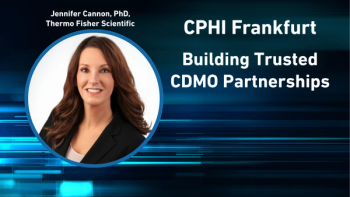
PTSM: Pharmaceutical Technology Sourcing and Management
- PTSM: Pharmaceutical Technology Sourcing and Management-12-07-2016
- Volume 11
- Issue 12
Internal and External Factors to Shape CMO Industry
M&A activity, new business models, fundraising limits, offerings from small CDMOs, and combination products are driving decisions in the contract services market..
Trade shows provide a good opportunity to gauge the temperature of the contract development and manufacturing organization (CDMO) industry and find out which trends and concerns are most on people’s minds. Five themes really stood out from conversations at the CPhI Worldwide event held in Barcelona in October 2016.
Pick your partner
Mergers and acquisitions continue to create the most buzz around the industry, and speculating about which contract manufacturing organizations (CMOs) are the next target or the next acquirer is a favorite topic of conversation. The industry certainly seems set up for a surge of mergers and acquisition (M&A) activity.
There are 15-20 private equity-owned CDMOs that have reached the typical five-year holding period that private equity firms seem to target. Further, the major industry players are focused on expanding their breadth of capability (i.e., the range of processing steps they can conduct and the number of technologies in their toolbox). Acquisition is the preferred pathway to expanded capability because it entails less time and less risk than internal development, and the need for specialized technologies (e.g., solubility enhancement or small-volume fill/finish) means that even small targets can be attractive to a large buyer.
Certainly the buy side of the M&A dance is eager to participate. The larger CMOs have access to both debt and equity financing, and acquisition is part of their story for equity investors. Many private equity firms are anxious to participate in the drug-development sector, and interest rates remain low. The big hurdle to M&A today seems to be inflated seller expectations of what they are worth. Buyers are willing to pay up, but not for the exorbitant multiples some sellers appear to be expecting.
Getting creative
CMOs are starting to get creative in how they work with their clients, especially the global bio/pharmaceutical companies. While the traditional one-size-fits-all contract manufacturing model is still the core of the business, CMOs are finding new ways to deconstruct their value proposition and reassemble the elements into new offerings more tailored to individual client requirements.
For instance, by offering dedicated suites equipped with client-owned machinery, they are enabling bio/pharma companies to enjoy the benefits of controlling their own production assets while avoiding the costs of building and operating an entire standalone manufacturing facility. There have also been discussions of CMOs taking over the operations of bio/pharma facilities without actually acquiring the sites, an arrangement that, among other benefits, enables the bio/pharma company to deal with unused capacity without having to create its own CMO business operation. Another model that is starting to spread is the CMO as a general contractor responsible for managing a product’s entire supply chain.
These new business models appeal to bio/pharma companies of all sizes and are proving to be particularly suited to housing new or product-specific manufacturing technologies where there isn’t an installed base of shareable capacity. These new models may also prove to be effective for addressing a big problem faced by global bio/pharma companies: an overwhelmingly large number of CMO relationships resulting from their licensing and acquisition activities.
Small is beautiful
While scale that can support breadth of capability is becoming increasingly important in the CMO industry, the opportunities for smaller service providers have been expanding rapidly. This is not just a function of the growth in the development pipeline and corresponding need for clinical trial materials; it also reflects the growing number of niche products that are getting commercial approval. CDMOs that would have been once considered only for clinical supplies are filling their capacity with small commercial products, both generic and innovator, and they are undertaking capacity expansion projects to address the demand.
The appeal of smaller CDMOs for commercial products is obvious: they are often more flexible and easier to work with than larger CMOs (which may not even want the smaller business), and their fill lines are often better suited to smaller batches, especially lower line losses of expensive APIs. But these opportunities don’t come without risks: smaller companies may not be able to afford the levels of quality assurance and regulatory compliance expertise that larger CMOs can offer, and they may not have the resources to respond quickly with remediation efforts when problems arise. Nevertheless, smaller CDMOs are addressing a growing niche in the market and are themselves becoming important acquisition targets.
Combination products
Combination products are becoming more prevalent as bio/pharma companies increasingly turn to drug-delivery devices to differentiate their products. Combination products create both opportunities and challenges for CMOs. The opportunities come from the growing demand for higher-value filling requirements, and the need to assemble and package the filled device. The challenges come from the non-standard nature of the devices and the fact that many of them are designed to appeal to the patient without much regard for manufacturability: most still require costly and complex manual assembly.
The combination device trend creates opportunities for CMOs to differentiate themselves through alliances with device makers, strategic relationships with clients sponsoring combination products, and innovations in device filling and assembly processes. The industry might also see more combinations of device developers and CMOs (e.g., acquisitions of device companies by CMOs or device companies moving into filling or assembly).
When will the music stop?
CDMO industry executives are keenly aware that emerging biopharma companies have enjoyed an extremely favorable fundraising climate in recent years, and how long the strong funding environment lasts is on their minds. A recent unpublished PharmSource analysis of data from
The financial markets certainly suggest some concern is justified. Initial and secondary public offerings remain way down from 2015 levels, and the NASDAQ Biotech Index is off 20% from its 2015 highs. Venture capital flows have remained steady, but emerging bio/pharma companies need support from public-market companies to maintain a high pace of development.
No one expects a precipitous decline in development activity in the foreseeable future, but CDMO executives are watching financial markets carefully to make sure they aren’t blindsided.
Articles in this issue
about 9 years ago
Factors to Consider in Dissolution Testingabout 9 years ago
New Opportunities for Cocrystalsabout 9 years ago
Analytical Method Validation Using QbD and QRMabout 9 years ago
Recipharm Collaborates with Laccure ABabout 9 years ago
Vetter Processing Center Receives Data Certificationabout 9 years ago
Idifarma Invests in Automatic Capsule Filling Capabilitiesabout 9 years ago
Catalent Expands Softgel Capacity with Accucaps Acquisitionabout 9 years ago
Patheon Acquires Roche API Siteabout 9 years ago
FDA Guidance Helps Further Clarify Quality Agreementsabout 9 years ago
PCI Expands Cryogenic Storage Facilities to Rockford SiteNewsletter
Get the essential updates shaping the future of pharma manufacturing and compliance—subscribe today to Pharmaceutical Technology and never miss a breakthrough.




